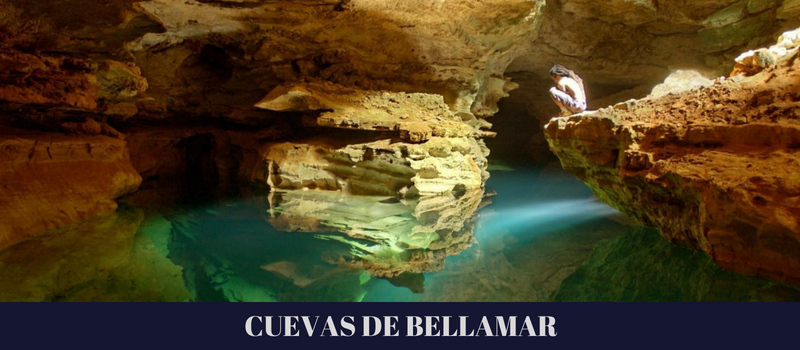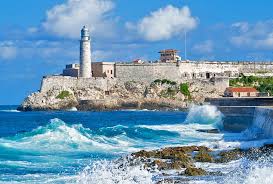LAS CUEVAS DE BELLAMAR, MATANZAS, CUBA. NUEVOS DESCUBRIMIENTOS. PHOTOS.
Las Cuevas de Bellamar son un conjunto de cavernas de mas de 23 kilómetros de galerias situadas en la provincia Matanzas, Cuba. Por la belleza de sus galería y cavernas, los importantes hallazgos paleontológicos, además de una amplia gama de procesos cristalinos fueron declaradas Monumento Nacional.
Las galerías y pasajes de las cuevas comenzaron a formarse hace unos 30 millones de años. Originalmente la llanura en la que se encuentran las cuevas se encontraba bajo el mar, formaba parte de la Bahía de Matanzas. Durante el fallo de llamada de las aguas subterráneas de Bellamar, en combinación con el dióxido de carbono se fue disolviendo la piedra caliza y creando así cámaras subterráneas en el subsuelo bajo el lecho marino. Mientras estas cuevas permanecieron bajo el nivel del mar se llenaron de agua. Luego, con consecuencias tectónicas (movimientos en las capas de la tierra), esta área se elevó, formando terrazas marinas que se notan en el terreno en la ciudad de Matanzas y sus alrededores.
HISTORIA SOBRE EL DESCUBRIMIENTO DE LAS CUEVAS
Las Cuevas de Bellamar fueron descubiertas por casualidad en febrero de 1861 cuando un esclavo perdió su barreta abriendo un hueco en el suelo, tratando de remover una roca de cal. El esclavo y el mayoral imaginaron que la tierra se había tragado la barreta.
Don Manuel Santos Parga, dueño de la finca, pidió explicaciones y al no recibir respuestas se dirigió al lugar de los hechos, ordenó que se cavara allí; y apenas se había abierto un espacio de poco más de una vara, salió por el agujero practicado una gran corriente de aire repugnante de olor; caliente y como humoso; entonces quedó así al descubierto la entrada de la cueva.
CARACTERISTICAS DE LAS CUEVAS. SUS FORMACIONES.
Las estalactitas son cilíndricas, y según aumenta su tamaño se hacen cónicas mientras que las estalagmitas son cónicas o aplanadas, como derretidas. Ambas crecen hasta unirse y formar columnas. En algunos casos varias estalactitas relativamente cercas se van uniendo, dando lugar a las formaciones llamadas matos. Otras corren próximas a la pared formando cascadas. En las Cuevas de Bellamar se ven todas estas formaciones.
Muy interesante en las Cuevas de Bellamar son sus formaciones cristalinas de aspecto transparente y brilloso las cuales no se originan de la misma manera que otras estructuras nombradas. Tienen su origen en geodas llenas de agua. Y más interesante resulta que en ciertas cavidades de las cuevas las formaciones sedimentarias son cubiertas por una capa cristalina, indicando que después de haberse secado, estas cámaras volvieron a inundarse totalmente, o al menos parcialmente.
ACCESO A LAS CUEVAS DE BELLAMAR
En el salón principal se encuentra la formación rocosa conocida como Manto de Colón. Esta es la más grande y antigua que se presenta en forma de cascada y tiene una altura de 12 metros. Dividida en cuatro sectores, sus galerías y salones están tapizados de estalactitas, estalagmitas y helictitas, estas últimas de caprichosas formas horizontales.
Estas cuevas presentan una belleza poco común en el mundo de las cavernas porque muchas de las formaciones son resplandecientes debido a la capa cristalina que las cubre. A las Cuevas de Bellamar se entra es por la cavidad llamada Salón Gótico, una cámara de forma cuadricular que mide unos 80 metros de largo por unos 25 metros de ancho.
La antigüedad de sus galerías y niveles permitió que sirvieran de refugio a la fauna cuaternaria de la región, hecho confirmado por el hallazgo en las excavaciones de restos de animales prehistóricos, además de ubicarse en el área la mayor cavidad de origen freático de Cuba.
NUEVOS DESCUBRIMIENTOS
De relevante interés científico valoran aquí los nuevos hallazgos en un segmento del Sistema Cavernario Bellamar: En la centenaria cueva un grupo de espeleólogos descubrieron una estrecha cavidad que los condujo a otra prolongación subterránea de unos nueve kilómetros de longitud. Para sorpresa de todos, encontraron allí galerías de incomparable belleza.
Se trata de formaciones cilíndricas pendientes de estalactitas, y suspendidas en el aire, en cuyos extremos cuelgan un conglomerado de cristales macizos de calcita. Por su dimensión y rareza los especialistas consideran el descubrimiento como joya exclusiva, incomparable con ningún otro hallazgo de su tipo. Son formaciones indescriptibles, por cuanto en ningún otro lugar del planeta se conoce semejante cristalería de carbonato de calcio.
En exploraciones continuadas por el grupo espeleológico Nacional han aparecido otros descubrimientos paleontológicos de significativo interés científico, como restos de vertebrados terrestres y aves cuya antigüedad la estiman en millones años. Entidades especializadas contabilizan a lo largo y ancho de la isla más de 10 mil cuevas, muchas de ellas con unos 25 millones de años de evolución.
THE CAVES OF BELLAMAR, MATANZAS, CUBA. NEW DISCOVERIES. PHOTOS.
The Bellamar Caves are a set of caves with more than 23 kilometers of galleries located in the Matanzas province, Cuba. Due to the beauty of its galleries and caves, the important paleontological finds, as well as a wide range of crystalline processes, have been declared National Monument.
The galleries and passages of the caves began to form about 30 million years ago. Originally the plain in which the caves are found was under the sea, it was part of the Bay of Matanzas. During the Bellamar groundwater call failure, in combination with carbon dioxide, the limestone was dissolved and thus creating underground chambers in the subsoil under the seabed. While these caves remained below sea level they filled with water. Then, with tectonic consequences (movements in the layers of the earth), this area rose, forming marine terraces that are noticeable on the ground in the city of Matanzas and its surroundings.
The Bellamar Caves were discovered by chance in February 1861 when a slave lost his crowbar opening a hole in the ground, trying to remove a rock of lime. The slave and the overseer imagined that the earth had swallowed the bar.
Don Manuel Santos Parga, owner of the farm, asked for explanations and when he did not receive answers, he went to the scene of the events, ordered that it be dug there; and as soon as a space of little more than a rod had been opened, a great current of the disgusting smell of air came out through the hole; hot and smoky; then the entrance to the cave was thus uncovered.
CHARACTERISTICS OF THE CAVES. YOUR FORMATIONS.
Stalactites are cylindrical, and as their size increases, they become conical while stalagmites are conical or flattened, like melted. Both grow to join and form columns. In some cases, several relatively close stalactites unite, giving rise to formations called Matos. Others run close to the wall forming waterfalls. In the Bellamar Caves, you can see all these formations.
Very interesting in the Bellamar Caves are their crystalline formations with a transparent and shiny appearance, which do not originate in the same way as other named structures. They originate from geodes filled with water. And it is more interesting that in certain cavities of the caves the sedimentary formations are covered by a crystalline layer, indicating that after drying, these chambers were completely flooded again, or at least partially.
ACCESS TO THE CAVES OF BELLAMAR
In the main hall is the rock formation known as Manto de Colón. This is the largest and oldest that is presented in the form of a waterfall and has a height of 12 meters. Divided into four sectors, its galleries and rooms are upholstered with stalactites, stalagmites, and helictites, the latter with whimsical horizontal shapes.
These caves present a rare beauty in the cave world because many of the formations are resplendent due to the crystalline layer that covers them. You enter the Bellamar Caves through the cavity called the Gothic Room, a square-shaped chamber that measures about 80 meters long by about 25 meters wide.
The age of its galleries and levels allowed it to serve as a refuge for the quaternary fauna of the region, a fact confirmed by the discovery in the excavations of the remains of prehistoric animals, in addition to being located in the area the largest cavity of phreatic origin in Cuba.
NEW DISCOVERIES
The new findings in a segment of the Bellamar Cave System are valued here of relevant scientific interest: In the centennial cave, a group of cavers discovered a narrow cavity that led them to another underground extension of about nine kilometers in length. To everyone’s surprise, they found galleries of incomparable beauty there.
They are cylindrical formations hanging from stalactites, and suspended in the air, at the ends of which hang a conglomerate of solid calcite crystals. Due to its size and rarity, specialists consider the discovery as an exclusive jewel, incomparable to any other find of its kind. They are indescribable formations because in no other place on the planet is such glassware of calcium carbonate known.
In continued explorations by the National speleological group, other paleontological discoveries of significant scientific interest have appeared, such as remains of terrestrial vertebrates and birds whose age is estimated at millions of years. Specialized entities count more than 10,000 caves throughout the island, many of them with some 25 million years of evolution.
Agencies/ Wiki/ EcuRed/ Extractos/ Excerpts/ Internet Photos/ Arnoldo Varona/ www.TheCubanHistory.com
THE CUBAN HISTORY, HOLLYWOOD.



 LAS CUEVAS DE BELLAMAR, Matanzas, Cuba. Nuevos Descubrimientos. PHOTOS. * THE BELLAMAR CAVES, Matanzas, Cuba. New Discoveries. PHOTOS.
LAS CUEVAS DE BELLAMAR, Matanzas, Cuba. Nuevos Descubrimientos. PHOTOS. * THE BELLAMAR CAVES, Matanzas, Cuba. New Discoveries. PHOTOS.







